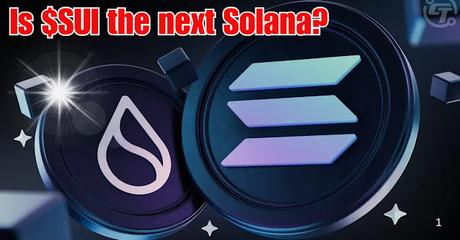While most of the market was going sideways, there was one coin that was absolutely killing it, and that's SUI. Up over 300% since August, SUI's price action made the entire crypto world sit up and take notice. You see, whenever a coin gets popular, people love comparing it to other projects.
Like they say, it's the next Ethereum, or the next Dogecoin potentially. But for SUI, that comparison is none other than Solana. Many people are saying that this is SUI's golden bull run and that it could do something similar to what Solana did last cycle. So I had to find out, if this comparison fair? Like, can SUI really become the next Solana?

Table of Contents
Why Solana Succeeded
Well, in order to answer that question, we gotta rewind a bit, and take a look at what made Solana successful in the first place. Solana launched in March of 2020, right before the Bitcoin halving, and it didn't take long for it to explode. It quickly became one of the top layer 1 blockchain in all of crypto.
But that begs the question, how was it able to rise so quickly? Well, if you do the research, you'll see that it came down to a few key factors. Cutting-edge technology, a rock-solid team, strong early backing, and the ability to build out its ecosystem efficiently. Everything lined up perfectly for Solana, and that allowed it to go from $40 million to a staggering $78 billion market cap in just one cycle.
But here's the thing, Solana didn't just ride the bull market to great heights. It also survived tough times, including a brutal bear market, and the collapse of its biggest backer, FTX. So when we see its current standing in the charts, we gotta appreciate everything it took to get there.
Solana Is Back | SOL will hit new highs soon! SOLANA Price Prediction 2025-2026
Tech Comparison
Now, when we turn to SUI, we see that it's still early in its journey, having just launched its mainnet last May. So it's kind of in a similar position to where Solana was at the beginning of the last cycle. But the real similarities start to appear when you look at the tech behind SUI.
Built by Mistin Labs, SUI is a next-generation layer 1 blockchain, designed to solve the scalability issues that plagued other blockchains in the past. Its goal is to deliver lightning-fast speeds with seamless scaling. But what makes it stand out is its unique approach to transaction processing.
Instead of handling transactions one by one, SUI handles them in parallel. This allows it to handle multiple transactions simultaneously, hence boosting its speed and making scaling that much more efficient. Now, going back to Solana, its foundation as a highly versatile, monolithic blockchain allowed it to adapt quickly to new trends.
Because it can support virtually any dApp or use case out there, Solana was able to tap into the narratives that drove the most usage and volume. This flexibility paid off big time, especially with sectors like memecoins or dPIN, which have both been booming lately. Now, in terms of SUI, it's set up in a similar manner that lets it capitalize on these opportunities.
Its scalable and fast infrastructure makes it flexible enough to support a wide range of use cases. But here's the catch, for SUI to really break out, it's crucial for it to find a niche that can propel it forward. At the moment, SUI is seeing a lot of activity in the social-fi space, which combines social media with DeFi.
But whether this will be the driving force that pushes SUI ahead, well, for that, we'll have to wait and see.
Is APTOS (APT) Really BETTER Then Solana & Ethereum?
Teams Comparison
Okay, so we've looked at the similarities in terms of tech, but what about the people behind the project? After all, a strong team can make or break a project, and for Solana, it was a huge factor in its success. At the heart of Solana's team are two key people, Anatoly Yakovenko and Raj Gokul.
What made this duo stand out was how well their skills complement each other. Yakovenko brings a deep technical background. He's a former Qualcomm engineer with experience in distributed systems and things like that.
Meanwhile, Gokul brings business savvy with experience in product management and venture capital. So together, they have the technical know-how and the business experience that every tech startup needs to succeed. But here's the thing.
It wasn't just their skills. It was also how they engaged with the broader community. They hosted numerous conferences, jumped on podcasts, and weren't afraid to debate with people on Twitter about blockchain design.
So this visibility helped them gain legitimacy, showing the crypto world that they were here to stay and that they meant business. Furthermore, Solana's team set big goals early on and were able to hit them consistently. They launched their mainnet just two years after starting.
From there, they had regular product launches such as Solana Pay in January of 2022, Solana Mobile Stack in June of that year, and then their mobile phone saga in April of 2023. Along the way, they also tackled key pain points such as the network issues that everyone used to clown on them for. So this shows a strong commitment to continuously improving, which is a must for any project that wants to succeed long-term.
So that's, of course, impressive for Solana. But how does Sui's team stack up? Well, Sui was founded by former meta engineers who worked on Diem, formerly known as Libra. So their background already put a spotlight on their project before it even launched.
One of their co-founders, Evan Chang, has a deep background in programming languages and distributed systems, while another co-founder, Sam Blackshear, created the Move programming language, which is not only used by Sui but also by Aptos.
So Evan and Sam's combined expertise allowed them to accomplish a lot in a short time. They launched Sui's mainnet just two years after their company formed, and they've made significant progress since then, like their Misticeti upgrade, which cut transaction latency down to just 390 milliseconds.
And that was a huge game changer for the user experience. So the point here is that Sui also has a strong team, perhaps not as accomplished as Solana's team, but it's early for them, so they definitely have time to catch up.
Algorand ALGO Crypto Huge Update and Price Prediction For 2024-25
Backing Comparison
Now, when we talk about the people behind a project, we also gotta talk about the backing they have, because even the best teams need support in order to succeed.
Well, Solana had incredible backing in its early days, especially from venture capitalists, and most notably, FTX. At the time, FTX didn't just provide funding. It went all in on the Solana ecosystem, launching projects like Serum, which gave Solana a massive boost and put it on the map big time.
Now, we all know what eventually happened to FTX, but back then, it was a juggernaut and anything that Sam Bankman III touched turned to gold. So with that kind of support, there's really nowhere for Solana to go but up. Sui, on the other hand, doesn't have a standout backer like FTX, but it still pulled in massive support, raising nearly $400 million across multiple rounds thus far.
That's actually slightly more than what Solana raised, but what's more impressive is that Sui did this during a bear market when Bitcoin was trading below $20K. Raising that kind of money in tough conditions suggests that Sui knows what it's doing and can succeed where others have failed.
Ecosystems Comparison
Anyhow, we've seen how solid the foundations are for both Solana and Sui, but what about what they've built on top of those foundations? Like, how promising are their ecosystems? Well, for Solana, ecosystem development has been a huge focus since day one.
Their foundation has launched several $100 million funds, first in 2021 for blockchain gaming, and then again in 2022 for South Korean Web3 startups. These funds have been crucial in bringing in developers, startups, and various projects. On top of that, the Solana Foundation hosts regular hackathons, which not only drives innovation but also helps them find key talent that they need to keep growing.
Now, Sui, in many ways, is following a similar path. They've been active in the hackathon space too, with their Overflow Hackathon drawing over 2,000 builders from 75 countries around the world. Also, Sui's own foundation has stepped up too, announcing a $50 million fund to support projects and accelerate their ecosystem's growth.
The takeaway here is that both projects are investing in their ecosystems, and that is set to pay dividends for them in the future.
Biggest Differences
Anyways, so far we've only discussed the similarities between Sui and Solana, but there are also some big differences between these projects. You see, crypto moves fast, and with Solana launched, the landscape was completely different from what it is now.
Back then, Ethereum was bogged down by congestion and high fees, so any Layer 1 blockchain that could alleviate some of those issues had a huge advantage. Solana was considered a top ETH killer for its fast and cheap transactions, and users flocked to it, giving it a massive early boost.
What really set Solana apart was its focus on usability.
The launch of Phantom Wallet, which is super user-friendly and works seamlessly with Solana, played a key role in bringing in new users. Paired up with easy-to-use DEXs like Radium and Serum, Solana stood out from the rest of the crowd. But Sui, on the other hand, is navigating a totally different environment.
Its Sui wallet isn't as developed as Phantom was at the same stage, and with so many other ecosystems offering their own tools, it's hard for Sui to stand out in this department. That said, Sui is still innovating with features such as wallet management with social accounts or Face ID, but with stiff competition from other Layer 1s, as well as the multitude of Layer 2s coming out these days, Sui's journey has got to be different from Solana's.
Also, if we compare adoption metrics between Solana and Sui, at similar points in their journeys, we see a notable difference.
In 2021, Solana was processing around 16.4 million transactions per day, nearly double the 9 million that Sui is doing right now. Also, while Sui is younger, its true transactions per second average around 100, while Solana's is currently around 3,000. Now, Sui does have some exciting catalysts in store, like the integration of USDC, a partnership with TikTok, and the launch of the Grayscale Sui Trust.
But all the metrics I look at show that Sui has a long way to go before it gets to Solana's level, so they got their work cut out for them.
My Verdict
But anyhow, after looking at all these similarities and differences, my personal take is that I don't think it's fair to label Sui as the next Solana. Truth is, Sui is navigating a very different market, and the comparison might actually downplay the unique path that it's on.
In my view, Sui is set up for a strong bull run and has a bright future, but catching up to Solana is going to be a tall order. By the way, if you're interested in hot new ecosystems like Sui, then you should definitely check out Base, as I'm a huge fan of that ecosystem too.

